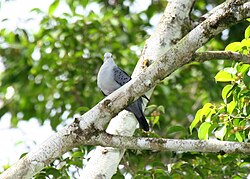Description
Blue ground doves are small pigeons, 20 cm long with a weight of 65–72 g. Adult males have blue-grey upperparts and paler grey underparts, becoming grey-white on the face. The flight feathers and outer tail feathers are blackish, and the wings are boldly spotted black (these spots often forming distinct bands). The iris is red or yellow, the bare eyering is green, and the legs are flesh-pink. The female has a grey-brown head neck and breast, becoming pale blue-grey on the underwings and belly. The back is ruddy brown, contrasting with the chestnut rump and tail. The spots in the wings are chestnut-brown. Young birds resemble the female, but have ruddy scaling on the back.
In most of its range, the male is unlikely to be confused with other species, but can locally be confused with the members of the genus Paraclaravis . The female also resembles the females of the members of the genus Paraclaravis, but at most localities it is more likely to be confused with the female ruddy ground dove, which is smaller and has blackish (not chestnut-brown) markings on the wings. In most regions where the blue ground dove occurs, a blue-grey and a brown bird flying through the trees together is bound to be this species.
This page is based on this
Wikipedia article Text is available under the
CC BY-SA 4.0 license; additional terms may apply.
Images, videos and audio are available under their respective licenses.




